Einführung
Die Post Immobilien Management und Services AG hat zur Auswertung der Arbeitsplatznutzung Locatee in über 20 Standorten ausgerollt, u.a. im Rechenzenter von Zofingen, wo MeteoViva Climate zur Optimierung des Raumklimas im Einsatz ist. Dabei wurden Daten von Locatee in MeteoViva Climate eingebunden, mit der Folge, dass präzisere Prognosen für das Raumklima erstellt und Ressourcen gespart werden können. Entscheidende Mehrwerte für Mitarbeitende, Eigentümer, sowie für das Facility und Corporate Real Estate Management Team können dadurch erzeugt werden.
Kostendruck und Nutzerzufriedenheit als Herausforderung
Für ein produktives Arbeitsklima ist für das Wohlbefinden der Mitarbeitenden zentral, wobei das Raumklima einen entscheidenden Einfluss hat. Ein solches Klima zu schaffen, birgt verschiedene Herausforderungen, u.a. der Kostendruck, welchem CREM und FM ausgesetzt sind. Einerseits sollen Ressourcen gespart, auf der anderen Seite optimale Bedingungen für die Mitarbeitenden geschaffen werden.
Im Rechenzenter Zofingen werden beide Herausforderungen dank MeteoViva Climate und Locatee adressiert: Locatee’s Belegungsdaten werden ausgewertet, um basierend auf der Gebäudeauslastung langfristig das Flächenangebot zu optimieren. MeteoViva Climate liefert die Datengrundlage zur Steuerung der Gebäudetechnik gemäss den effektiven Bedingungen, womit einerseits das Raumklima verbessert wird und andererseits Ressourcen wie Heiz-/ Kühl- und Lüftungskosten eingespart werden.
Zu den Unternehmen
MeteoViva
MeteoViva Climate ist die Zukunft des Gebäudemanagements: vorausschauend, selbstlernend, mit über 3,5 Millionen Betriebsstunden Erfahrung in Gebäuden weltweit. Die modellbasierte Smart-DataLösung erzeugt ein optimiertes Raumklima und senkt gleichzeitig Betriebs- und Energiekosten sowie C02 – Emissionen deutlich.
Locatee
Locatee ist die führende Workplace Analytics Lösung für die Optimierung von Arbeitsräumen durch detaillierte Einblicke in die Raumnutzung. Locatee ermöglicht es grossen Unternehmen, faktenbasierte Entscheidungen hinsichtlich Ihrer Immobilien zu treffen, und verändert die Art und Weise, wie die Mitarbeitenden mit den Gebäuden interagieren..
Zusammenfassung
- Investition in die Nachhaltigkeit aufgrund der erstmaligen Einbindung von Locatee’s Belegungsdaten in MeteoViva Climate
- Verbesserung des Raumklimas für erhöhte Nutzerzufriedenheit
- Optimierung von HLK kann zu Ressourcenersparnissen von bis zu 45% führen
Wie es funktioniert
Die Kombination zweier Smart Data Plattformen als Lösung
Bis anhin verwendete MeteoViva Climate für die Prognose der Raumbelegung statische Tagesund Wochenprofile. Neu werden die von Locatee gemessenen Belegungsdatendaten von MeteoViva Climate übernommen. Damit werden dynamische Profile generiert und Prognosen für die Raumbelegung der nächsten Tage berechnet. Mit diesen Informationen kann die Auswirkung der Anzahl zukünftig anwesenden Mitarbeitenden auf das Raumklima im Voraus sehr genau simuliert werden. Der nötige Heiz- oder Kühlbedarf und die Frischluftzufuhr werden bedarfsgerecht und «just in time» gesteuert.
Highlights
Die Optimierung des Raumklimas führt zu einer Steigerung des Wohlbefindens Ihrer Mitarbeitenden, was einen positiven Effekt auf die Produktivität hat.
Die Analyse und Auswertung verlässlicher Datenquellen ermöglicht einen vereinfachten Gebäudebetrieb basierend auf objektiven Messwerten.
Ein an die aktuellen Bedürfnisse angepasster Einsatz von Heizung, Kühlung und Lüftung leistet nicht nur einen Beitrag an die Umwelt und Nachhaltigkeit, sondern lässt Sie auch Kosten senken.
„Dank der Einbindung von Locatee in MeteoViva Climate wird der Betrieb der gebäudetechnischen Anlagen optimiert und Kosten können eingespart werden. Die Behaglichkeit in den Büros hat sich signifikant verbessert, was zu einer erhöhten Mitarbeiterzufriedenheit führte.”

Die Ergebnisse
Kosteneinsparungen und ein verbessertes Raumklima: Nutzen für Management und Mitarbeitende
MeteoViva Climate schafft ein angenehmes Raumklima für die Mitarbeitenden, was zu verminderten Beschwerden aufgrund weniger Luftzug und geringeren Temperaturschwankungen führt. Dies wird ermöglicht, indem MeteoViva Climate die Anlagen optimal steuert und zugleich für einen möglichst niedrigen Energieverbrauch sorgt. Das Facility Management benötigt weniger Zeitaufwand für die Betriebsüberwachung, wie auch für das Energiemanagement und nötige Eingriffe können gezielt vorgenommen werden. Insgesamt wird in die Nachhaltigkeit des Gebäudes investiert und somit der Wert des Gebäudes gesteigert: Im Rechenzenter Zofingen konnte die Zielsetzung erreicht und die Behaglichkeit in den Büroflächen spürbar verbessert werden. Der Wärmeverbrauch wurde um bis zu 5%, der Kälteverbrauch um bis zu 45% und der Stromverbrauch um bis zu 20% reduziert.
Introduction
UPC Schweiz GmbH is using occupancy data for their decision making. Reto Landert, Facility Manager at UPC Schweiz GmbH, states that using Locatee‘s objective and reliable data led them to added-value on different levels.
Company Info
UPC Schweiz
UPC Schweiz GmbH is one of the leading telecommunications and media providers of Switzerland with more than 1‘500 employees.
Benefits Highlights
Increased Space Utilization
Satisfy Space Requests
Management Reports
Identify impacts on utilization
„The trustworthy data allows us as CRE to lead discussions with our CFO on an objective level and to define and achieve different target utilisations across our office buildings – while also taking into account our employees‘ well-being.”

The Results
- Identification of under-utilised areas and floors. As an example, in one office building 4’500 sqm could be subleased, which yielded in substantial cost reduction and helped increase the space utilisation to the targeted 85%.
- Pro-active retention of 900 sqm that were temporarily not in use due to volatile projects. This area helps to easily and quickly react on future space requests from the business lines and to satisfy their needs.
- Automatically created management reports of the present and historical space utilisation.
- Pro-active identification of organisational changes and how these affect the space utilisation, e.g. identification when a project phase ends and the respective desks are no longer required.
Introduction
New Headquarters with a Modern Challenge
By moving the headquarters to a new office building in Bern Wankdorf, Swiss Post stepped into a modern work environment. As part of the increasing mobility within the company, Swiss Post employees are able to flexibly choose a workplace according to their current task at the new location. In the approximately 30,000m2 office space, more than 2,000 employees can take advantage of different areas, such as zones dedicated to individual work or interaction with others. This flexibility presents new challenges for managing the office; the availability of the right number of different workplaces and the optimal use of space must be ensured at all times. For example, the following questions arise:
- Where in the building are capacities currently available?
- How do the utilization and vacancies develop in the longterm?
- Which workspaces are used when and how frequently?
Challenges Arise
The flexible work environment posed many new challenges: the availability of the right number of different workspaces and the optimal use of space must be ensured.
Summary
- The modern work environment in the new Swiss Post headquarters posed new challenges regarding capacity planning and employee experience.
- Swiss Post rolled out Locatee across 30,000m2, covering the workplaces of more than 2,000 employees.
- Smart Signage enables employees to find workspaces and resources easily.
- With Locatee Analytics the sharing ratios of desks were optimized and 15-20% of office space savings were achieved.
How it works?
The Solution is Big Data
To answer these types of questions, Swiss Post pursued a data-driven approach and therefore chose to use the data solution by Locatee. The patented technology developed by the Zurich-based company evaluates thousands of data points from the existing LAN and Wi-Fi network infrastructure in realtime to determine which desks and meeting rooms are in use. Various data visualization options make it possible to assess the utilization of the entire building. To protect the employee’s privacy, the data is anonymized and aggregated irreversibly. T
Benefits Highlights
Savings Potential
Savings potential of 15-20% of office space costs was achieved after Swiss Post’s implementation of Locatee.
Find Workspaces Easily
Smart Signage allows employees to quickly find available workspaces in the office.
Prevention of Food Waste
Notifications sent to canteen helped estimate the number of meals to prepare and prevent food waste.
The Results
Optimization of sharing ratio
Using Locatee Analytics, Swiss Post is determining how departments use their assigned areas. By improving the home bases in their headquarters, they found potential to consolidate further buildings by adding 150 employees into their headquarters. A savings potential of 15–20% of the office space costs was achieved.
Retain great workspace experience
Swiss Post started consolidating their headquarters in July 2017 and identified that employees from other locations struggle to find meeting rooms and resources. In order to improve collaboration between employees and facilitate finding free workplaces as well as shared resources, Smart Signage was rolled out. This is accessible for all employees in the intranet, and live information is displayed on screens in the lobby.
„For us, the main advantage is that we have a purely data-based solution that does not require hardware investments of any kind – this was also the reason we chose Locatee Analytics.”

Canteen notification
An automatic notification is sent to the canteen, reporting the number of people present in the office at 10am. The canteen uses the information to estimate the number of meals to prepare, leading to the reduction of food waste.
Conclusion
Comprehensive and continuous utilization data down to work zones creates the necessary transparency for workspace management. This allows vacancies in the building to be identified easily, making workspace management more simple and effective. Furthermore, the insights are used to ensure that the work environment at Swiss Post stays up-to-date with the employee‘s needs and that the available space can be managed efficiently and sustainably.
Intro
Adrian Dömer, Abteilungsleiter Immobilien & Infrastruktur an der FHNW, erläutert Locatee in einem Interview, wie er von der Lösung zur Arbeitsplatzanalyse profitiert. In diesem Video erfahren Sie, wie die FHNW Locatee einsetzt!
Porträt
FHNW
Die FHNW ist eine der führenden Fachhochschulen in der Schweiz und ist mit ihren neun Hochschulen in Lehre, Forschung, Weiterbildung und Dienstleistung tätig – innovativ und praxisorientiert. Ihr breites Angebot an Studiengängen, ihre Nähe zur Praxis, ihre anwendungsorientierte und innovationsstarke Forschung sowie ihre weltweite Vernetzung machen die FHNW zu einer attraktiven und vielfältigen Bildungsstätte, zu einer nachgefragten Praxispartnerin und zu einer attraktiven Arbeitgeberin in der Nordwestschweiz.
Interview Script
1. Welche Herausforderungen haben dazu geführt, dass nach einer Workplace Analytics-Lösung gesucht wurde?
Es waren die endlosen Diskussionen darüber, wer wieviel Raum zur Verfügung hat in Kombination mit einem starken Wachstum letztes Jahr, bei dem gewisse Institute mehr Raum brauchten, wobei alle das Gefühl hatten, keinen Platz bzw. zu viel Platzt zu haben – nein, zu viel hatte eben niemand. Wir wollten etwas haben, das schwarz auf weiss nachweist, wie die Räume ungefähr ausgelastet sind.
2. Was waren die Gründe, weshalb Locatee ausgewählt wurde? Was machen wir besser im Vergleich zu anderen Anbietern?
Zuert haben wir Sensorlösungen angeschaut. Sensoren in unserem Testgebäude mit 25’000m2 Hauptnutzfläche – ich weiss nicht, wie viele tausend Sensoren wir da hätten verbauen müssen. Es war sicherlich ein Kostenaspekt, auf der anderen Seite haben wir eine bestehende IT-Infrastruktur basierend auf dem Cisco-System und es hat sich dann so ergeben, dass wir auf Locatee aufmerksam geworden sind. Dann haben wir Locatee einmal genauer angeschaut und gemerkt, dass es vom Betrieb und den Kosten her für uns vermutlich einfacher ist, wenn wir auf diese Lösung setzen und das ausprobieren.
3. Welches ist der wichtigste Use Case? Was ist der Hauptnutzen, den Du/Ihr daraus ziehen kannst/könnt?
Der Hauptnutzen von Locatee ist, dass wir die Emotionen aus Diskussionen fernhalten können in Bezug auf die Raumbelegung. Dadurch, dass wir es grafisch darstellen können, ist es schlussendlich einfacher, zu einem Entschluss zu kommen. Das ist der wesentliche Punkt.
4. Wie gestaltet sich die Zusammenarbeit mit Locatee?
Cool, richtig gut! Als Kunde habe ich mich immer ernst genommen gefühlt. Es findet ein regelmässiger Austausch statt: ein Mitarbeiter, Andi Meier, der dafür zuständig ist, hat einmal wöchentlich einen Standardkontakt, bei dem aktuelle Probleme besprochen werden. Man wird ernst genommen. Eine gute Sache.
5. Es wurde vor Kurzem ein Mehrjahresvertrag unterzeichnet; welche Ziele verfolgt die FHNW mit Locatee? Gibt es eine Langzeitstrategie, für die Locatee im Einsatz ist?
Der Mehrjahresvertrag wurde abgeschlossen, weil wir die Erfahrungen, die wir hier in Brugg-Windisch gesammelt haben, auch an anderen Standorten nutzen wollen. Das Ziel ist, dass wir bis Ende 2019 80% von unserem Flächenbestand überwachen können, bzw. die lokalen Leute vor Ort die gleichen Möglichkeiten haben wie wir hier, da wir nach wie vor Wachstum im ganzen System aufweisen und stetig optimieren müssen. Die Wahrscheinlichkeit, dass wir mehr Geld erhalten durch unsere Träger, den Bund und die Kantone, ist eher gering. Aufgrund des daraus resultierenden Drucks ist es natürlich die Idee, dass bestehende Ressourcen optimiert werden.
6. Wie siehst Du die Zukunft von datenbasierten Facility Management-Entscheidungen?
Es wird immer mehr wachsen in der nächsten Zeit. Wir selbst haben zwei Projekte am Laufen: Einerseits eines basierend auf Locatee-Daten im Bereich Reinigung mit zwei unterschiedlichen Anbietern, wobei es darum geht, zum richtigen Zeitpunkt die richtigen Orte zu reinigen – das wird sicherlich sehr spannend. Wir haben die Hoffnung, dass wir unseren Kunden, sprich den Mitarbeitenden und Studierenden ein besseres Angebot bieten können. Das andere Projekt besteht darin, dass wir unsere Planungsprozesse optimieren können. Wir wollen Locatee Live-Daten abgleichen können mit den Belegungsdaten von unseren Raumbuchungssystemen. Dann bringen wir vermutlich die No Shows aus den Planungsprozessen raus. Hier haben wir die Hoffnung, dass wir auch im Unterrichtsbereich zusätzliche Kapazität schaffen können, die wir bis anhin einfach noch nicht gesehen haben mit den aktuellen Planungstools, die wir haben.
Introduction
Offices all over the world are currently shuttered due to the COVID-19 pandemic. This results in various challenges for corporate real estate and facilities managers, ranging from how to maintain an unused office space to monitoring the number of people still working from the office. Zurich Insurance developed its own strategy to master this situation by using the relevant data provided by Locatee.
Company Info
Zurich Insurance
The insurance company has rolled out Locatee in multiple buildings throughout Switzerland in the Workplace Operations Plan. In their headquarters in Zurich, Locatee is being used to monitor the office building utilisation for strategic and operational real estate decisions.
Summary
- During the COVID-19 pandemic, Locatee‘s data is used to monitor the daily peak utilization.
- Daily reports are created for the management to verify the maximum number of people located in the office.
- Measures were taken to reduce the occupancy in zones with too high a utilization.
- For the top management it is of great importance to have reliable insights during the crisis.
- The existing Cisco LAN & WiFI infrastructure allowed to measure workspace utilization in real-time, without additional hardware.
Requirements
At their headquarters in Zurich, people in charge of business-critical tasks or events are currently still working from the office, while everyone else is urged to work from home. In order to be able to comply with government policy and to protect their employees, the management team at Zurich Insurance requests daily reports with key data points and indicators, such as the overall peak utilization of a building as well as that of different zones. Patrick Preisendanz, CAFM Specialist at Zurich Insurance Switzerland, prepares those reports and monitors all relevant data.
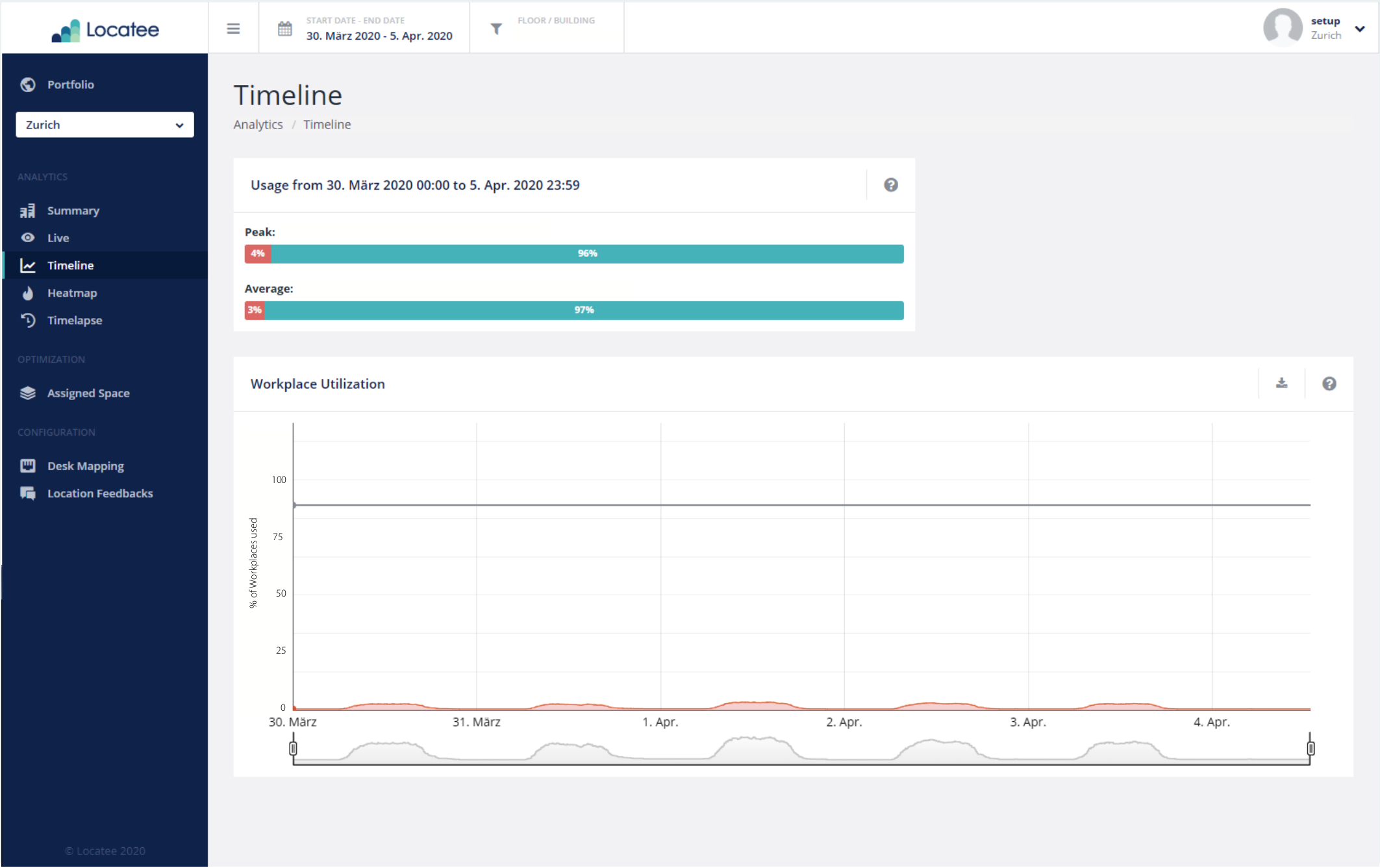
Locatee Analytics
Timeline View with Daily Peaks
The Result
A color system to visualize office occupancy
The workplace utilization data provided by Locatee, based on Cisco’s IT Infrastructure, enables Patrick Preisendanz’s access to the required insights. Using the Timeline View of Locatee Analytics, he is able to oversee all floors and zones in order to monitor the daily peak utilization and to identify the time at which they occur. A color system has been introduced to visualize which areas are approved, critical or even over-utilized. Through the allocated home bases of the departments, all areas with a too much utilization could be approached and consequently the daily peaks successfully decreased. The peak utilization has now stabilized at a value of around 4%.
As the utilisation has reached its target value, Zurich Insurance is now able to start improving operational efficiency and use the data to select areas where office resources can be reduced and unused devices such as coffee machines can be shut down.
The value of peak utilization
While normally the insights into average utilization are used for strategic decisions at Zurich Insurance, now the peak utilization is providing the relevant data. After a short period of adjusting to these new circumstances, an immediate collaboration and regular exchange
between Zurich Insurance and Locatee made it possible to regain control over this exceptional situation.
„Locatee data took a lot of importance during the last weeks and was needed in order to implement the necessary measures taken by the management.”

Outlook
Already anticipating the return of employees to the office, Patrick Preisendanz also plans to use Locatee’s data to monitor this future process with the same color system – this time in reverse. Most probably, there will be different stages of the number of people allowed to go back to office work, including staggered office hours. Monitoring this successive process will be key for a successful return to business as usual.
Introduction
Locatee enables Swiss Re to design the office of the future with portfolio-wide location-based services and space optimization. This case study shows how it allows Swiss Re to design the office of the future.
Company Info
Swiss Re
Swiss Re is one of the world’s leading providers of reinsurance, insurance and other forms of insurance-based risk transfer. They have implemented Locatee Analytics in their office buildings around the globe.
Netcloud
Netcloud is one of Switzerland‘s leading experts in planning, implementing, and managing ICT solutions. Their focus is broad knowledge and vast experience in the areas of Security, Network, Collaboration, Datacenter, Managed Services, Cyber Defence, Professional Services and the Cloud.
Summary
- Swiss Re‘s journey to becoming a digital enterprise, involved aligning the office design with employees needs and the company‘s vision.
- To realise this, Swiss Re turned to Netcloud as a strong IT-partner and combined Cisco‘s network infrastructure with Locatee‘s solution.
- This allowed to measure workspace utilisation in real-time and without additional hardware.
- With the insights of Locatee, Swiss Re identified unused space and has already realised savings potential of EUR 290.000 per year alone in their Munich office.
How it works?
Designing the Office of the Future
Whether you’re an employer or an employee — office design matters. For employees, it‘s a quality that makes you proud to come to work. It might have even factored into your decision to join the company in the first place. For employers, enabling your employees
through thoughtful, high-functioning office design has a huge impact on the company’s bottom line.
As one of the world‘s leading providers of reinsurance and insurance, Swiss Re is dedicated to making the world more resilient — and that begins at their headquarters. Swiss Re offers fresh perspectives, knowledge, and capital to help business of all types better anticipate and manage risk. To accomplish these goals, employees need a supportive office design, which is why Swiss Re launched the Smart Building and Service Solution Initiative. To realise the project Swiss Re needed a strong partner and therefore turned to Netcloud – Switzerland‘s leading experts in planning, implementing, and managing ICT solutions.
„Nachdem Netcloud die Cisco- und Locatee-Lösung in München und Bratislava erfolgreich als Pilotprogramme implementiert hatte, waren wir mit der Skalierbarkeit und den Ergebnissen so zufrieden, dass ein globaler Ausbau der logische nächste Schritt war. Heute optimieren wir Arbeitsbereiche auf sechs Kontinenten.”

Real-Time Insights Require Real-Time Data
Once the scope of the project was defined, Netcloud acted as a “general contractor“ and with Swiss Re’s underlying data of the Cisco infrastructure, Netcloud suggested to build on top with Locatee‘s solution. By allowing Cisco to team up with Locatee, the existing IT infrastructure was leveraged and allowed the analysis of workspace utilisation across the entire real estate portfolio, individual buildings, floors, and departments. This approach helps to reduce maintenance to a minimum while providing continuous and real-time
data. The insights allow Swiss Re to reduce costs, while also ensuring employees needs are being met – just in a more efficient manner than ever before.
Benefits Highlights
Leveraging the Existing IT Infrastructure
The workspace analytics platform is designed to collect data from an IT network, thus providing real-time workspace insights.
Power of New Insights
The solution enables to see which buildings are underutilized and why, drilled down to specific floors in various offices.
Visibility of the Entire Portfolio
Seeing the whole porfolio enables to optimise resources everywhere for maximum impact from both a design and financial perspective.
The Results
An Investment in Your Employees
Locatee‘s platform was rolled out throughout the entire real estate portfolio and allowed the Corporate Real Estate team to make fact-based decisions.
- Easy implementation: The solution was deployed remotely by Netcloud and Locatee. Now Swiss Re has portfolio-wide visibility and is able to optimise resources for maximum impact from both a design and financial perspective.
- Real-time insights: The insights show which buildings are underutilised and why. By taking a granular look at the data, even down to specific floors in various offices. Key stakeholders such as Corporate Real Estate and Facilities Management have access to data and can extract valuable insights out of it.
- Realising savings potential: Based on insights from Locatee, Swiss Re decided to decrease the space in the Munich Office by 10% because it wasn‘t utilised and could be reduced without detriment to the employees. The reduced space included workplaces, shared offices, meeting rooms, and think tanks. The reduction will save €290,000 per year in the Munich office alone
„Der finanzielle Nutzen für Swiss Re ist offensichtlich – wir können jetzt viel besser bestimmte Chancen ergreifen, von deren Existenz wir vorher gar nicht wussten. In unserem Münchner Büro konnten wir die Büroflächen um 10 % reduzieren, wodurch Swiss Re jährlich 290’000 EUR einspart. Stellen Sie sich das Potenzial vor, das sich da für unser gesamtes Portfolio ergeben würde.”

Insights to Power the Future
The financial benefits to Swiss Re are obvious. It will now be easier to see where time, money, and attention should be directed to have the biggest impact on long-term goals. In addition, it will enable employees to work smarter on a daily basis. The insights that they now have available will enable to create higher functioning, more productive, and more collaborative offices for their employees. The leading companies of tomorrow invest in their employees today.
Introduction
Biogen’s headquarters currently accommodate over 450 employees across four buildings, and a total of 12 floors. Due to the highly spread out nature of these office spaces Biogen’s management requested a site evaluation with the purpose of optimizing its long-term workspace strategy.
Company Info
Biogen
Biogen is a leading American Biotech company developing therapies for patients with serious neurological, autoimmune and rare diseases, with its international headquarters in Zug, Switzerland. These headquarters currently accommodate over 450 employees across four buildings, and a total of 12 floors. Due to the highly spread out nature of these office spaces, Biogen’s management requested a site evaluation to optimize its long-term workspace strategy.
Summary
- Biogen rolled out the Workplace Operations plan across four buildings and 28 departments.
- With Locatee Analytics Biogen identified areas with available capacity for potential ‘collaborative’ or ‘silent’ workspaces.
- An increase in the desk sharing ratio enabled Biogen to bring in 140 employees to the existing 450 without adding any square metres and improve space efficiency by 30%.
- In total a savings potential of CHF 2.5 million was realised.
How it started?
Workspace Demand as a Starting Point
Biogen’s facilities team realized that this optimization required a detailed understanding of the organization’s current space demands in order to ensure long-term workspace performance. One possible alternative was going in the direction of the currently trending ‘flexible workplace concept’, including shared desks, dedicated ‘collaborative’ spaces, and a ‘silent’ working environment. However, in order to provide Biogen’s leadership team with several alternative workspace strategies, key data and insights on actual workspace utilization were required. This included planning scenarios such as housing additional employees without adding extra workspace.
The decision to use a Big Data approach
In order to obtain these insights, and the data required for a site evaluation, Biogen looked at a variety of solutions aimed at helping them best understand their organization’s current workspace requirements. “We compared a variety of occupancy sensor solutions with Locatee’s big data approach. The non-intrusive, scalable and cost-efficient nature of Locatee Analytics convinced us that its approach was best suited for our requirements,” said Nicole Stutz, responsible for Office and Facility Management at Biogen.
„Understanding how an organisation uses its workspace is fundamental to creating an effective and efficient working environment. Thanks to Locatee Analytics we were able to obtain granular insights into our space utilisation and take workspace decisions with great confidence; simply based on our existing IT infrastructure!”
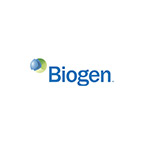
Benefits Highlights
Identify Growth Potential
With changing the sharing ratio to 0.75 a growth potential of 150 employees witout adding square meters was identified.
Optimising
Space
Increase of space efficiency by up to 30% through identifying department needs.
Cost
Savings
Total cost savings of CHF 2.5 million through optimised utilisation and workspace insights.
The Results
Insights from Locatee Analytics
Within a short time, Locatee’s solution was rolled out across all four buildings and 28 departments. The patent-pending big data solution analyses real-time connections of employee devices such as laptops, through the existing network infrastructure. It determines which workplaces are in use at any time, thus providing workspace utilization data down to a single desk. In order to ensure employees’ privacy, the data is completely anonymized and aggregated. Identifying department demands: As such, these visualizations of utilized and vacant space across campus generated by Locatee Analytics accurately detail the workspace demands of the analyzed departments. These insights enabled Biogen to identify areas with available capacity for potential ‘collaborative’ or ‘silent’ workspaces. Furthermore, a break-down of the office utilization by department allows the real estate management to effectively communicate with department leads and have continuous conversations about each department’s space needs and utilization
Growth without adding space
Further useful insights demonstrated that including a shared desk environment and, as a result changing the desk/ employee ratio to 0.75, would allow for future potential organisational growth of up to 150 employees without having to add a single square meter of additional office space. Such an increase in the utilisation of existing workspace would allow Biogen to improve space efficiency by up to 30% and lead to costs savings. „These workplace insights prove to be very valuable for us! Locatee Analytics not only reinforced our gut feeling, but took the discussion we had within our management to a new, more objective and data-driven level. Taking decisions about space utilisation without such data can be risky, so we are very appreciative of the insights Locatee Analytics is able to provide us with,” concludes Nicole Stutz.
Introduction
Setting out to improve the way cleaning services use the digital tools available
nowadays, Deloitte has successfully piloted Smart Cleaning with their facility
management service provider and were on top of that able to optimize resources
used and time spent thus leading to cost savings.
Company Info
Deloitte
Deloitte is one of the Big Four global audit and consulting firms. They have implemented Locatee Analytics across their office buildings in Switzerland. Deloitte Switzerland has an office portfolio of 14,000 sqm for their 2,200 members of staff. They are highly invested in testing innovative real estate and facilities management practices and are showcasing them also in their consulting mandates.
Soobr
Soobr is a PropTech company based in Switzerland. Their platform and application allow for optimization and demand-driven planning and execution of cleaning tours based on data and artificial intelligence.
Summary
- Deloitte and their FM service provider set out to improve organization of cleaning
processes and communication with cleaning staff distributing work more
dynamically. - They have successfully piloted a new approach using the Soobr application that is
fed with real-time utilization data from Locatee Analytics. - Their main goal was to improve processes, evidence, and communication.
- At the same time they were able to optimize cleaning routines saving resources
and consequently cost. - All while maintaining a high cleaning standard to keep quality & hygiene
during the pandemic.
How it works?
Smart Cleaning
The Corporate Real Estate and Facility Management industry alike are oftentimes put on the spot for not being at the forefront of digitization and exploiting solutions on the market. Deloitte has proven the opposite with their Smart Cleaning project.
Their FM service provider felt there was a better way to organize cleaning schedules than by paper instructions. Namely, to distribute work more dynamically, setting task priorities based on utilization information and also including a feedback functionality to report on defects.
„Our service provider now has more detailed insight into cleaning performance, and can adapt to building utilization while improving job satisfaction for their staff – a win-win situation for all.”
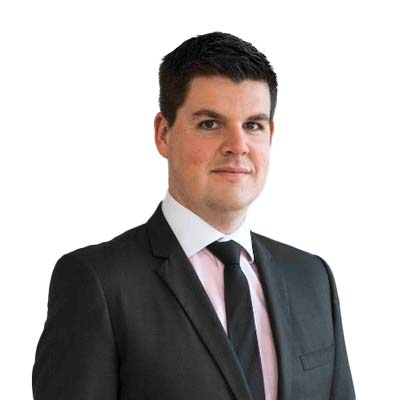
Early on they had tested a new planning mode by combining Locatee’s utilization heat maps and information from sensor technology in the sanitary areas to count the number of door openings, but there was still a touchpoint missing to make that information easily available to cleaning staff on the ground.
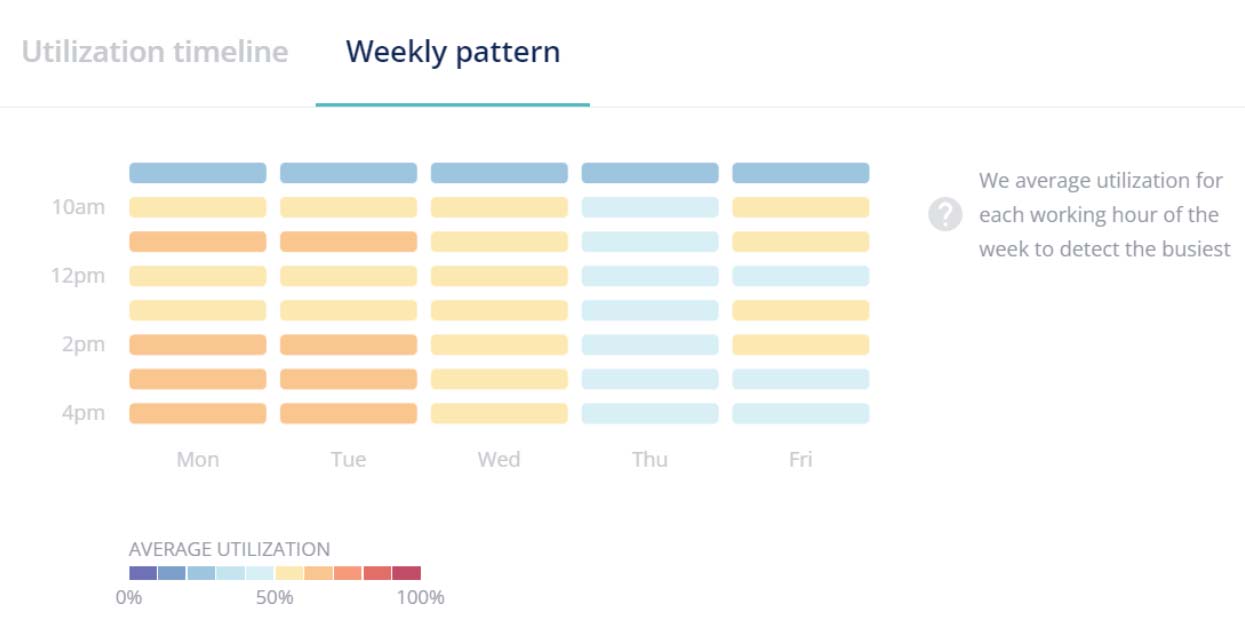
Weekly pattern overview
showing average utilization for each working hour
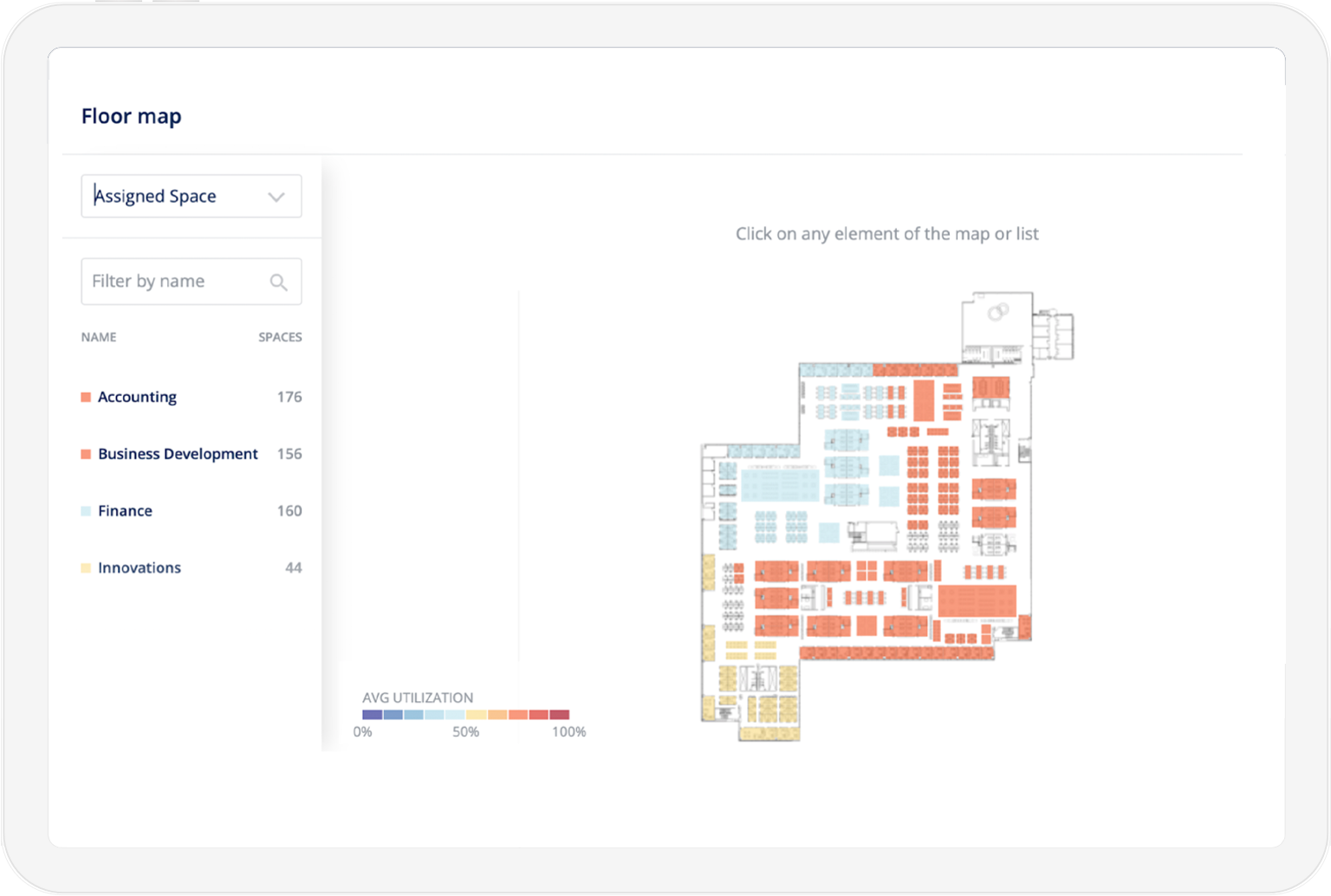
Floor map view
on Locatee Analytics showing utilization of different zones
That’s how Soobr came into play.
The basic application is set up with space information derived from floor plans or Raumbücher (applicable in the DACH region) and the service-level agreements for cleaning. With that, cleaning routes can be planned and cleaning personnel will get their schedule when they start their shift on a tablet app.
But in order to take it one step further and unlock the full optimization, potential usage data is required. Deloitte was able to take the utilization information for different office zones from Locatee Analytics. For enclosed rooms, utilization information was integrated into the Locatee platform from presence detection sensors that regulate air quality or taken directly from sanitary area door sensors.
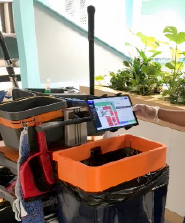
off as done once they are finished.
That way, it is also possible to report on the cleaning carried out without having to fill out paper forms. Additionally in the same interface, cleaning personnel can report on necessary maintenance, such as broken light bulbs, stains on the carpet, and anything else they see, with icon buttons, thus avoiding any language barriers.
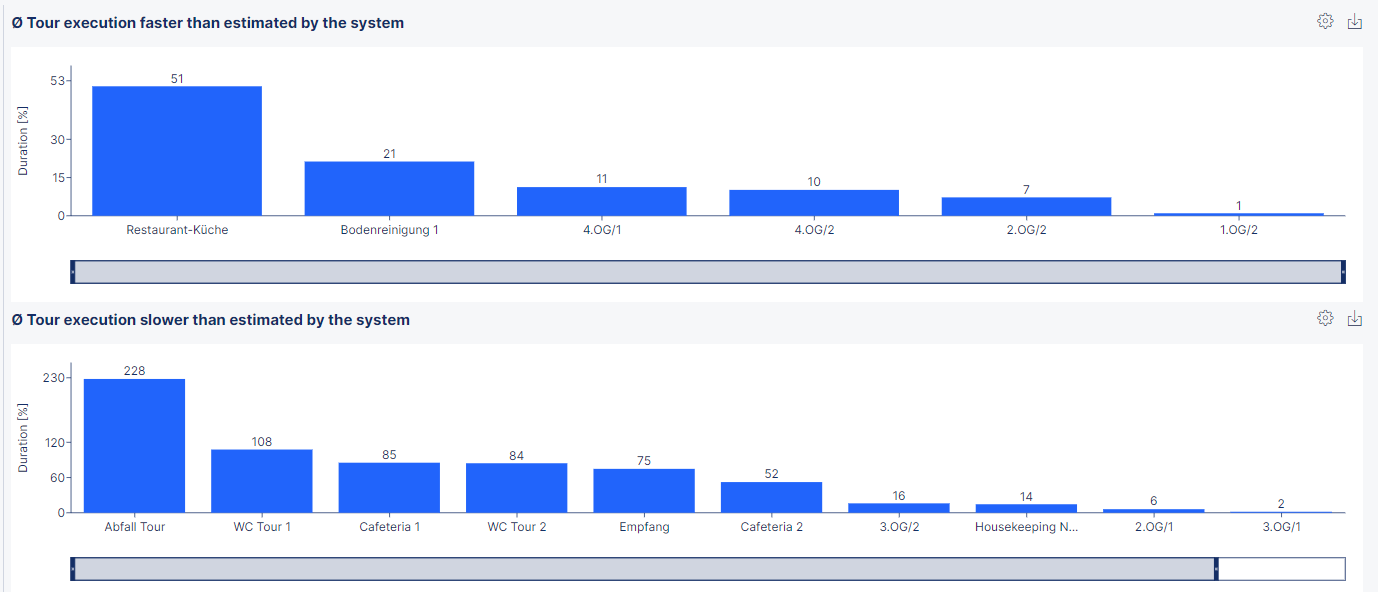
Soobr App Dashboard
The information is visible for Deloitte at any time on live dashboards. Their FM service provider also shares monthly reports on cleaning tours, duration, number of defects and the washroom usage for instance. This increased the transparency of a service that usually takes place out of office hours.
Benefits Highlights



The Results
Evidence & Reporting
Besides the clear evidence for Deloitte as the customer, their FM service provider benefits from more detailed insights into cleaning performance. When reviewing cleaning routines, it became clear that repetitive, time-consuming tasks, for instance long floor areas, could be better managed by a robot. They can also plan more flexibly, for instance when reassigning tours when a member of staff is unavailable.
Cleaning Staff Satisfaction
A very compelling outcome is that employee satisfaction with cleaning staff has increased as people felt their jobs were appreciated and upgraded by the digitization as well as outcomes clearly measured. Plus, the language barrier has been removed with intuitive visualizations and a selection of supported languages. Consequently, there is very small fluctuations in staff.
„Our service provider now has more detailed insight into cleaning performance, and can adapt to building utilization while improving job satisfaction for their staff – a win-win situation for all.”

Taking the leap and moving to a smarter approach to cleaning has paid off for all collaboration partners. Deloitte is showcasing the service model and collaboration with peers and clients as a best practice and is also including learnings in their consulting mandates.
Efficiency & Cost Savings
Leaning on utilization data enabled cleaning services to become more efficient with less cleaning products which supports their sustainability goals. With the cost savings from reduction of time spent and materials used the first year, the project was delivered to Deloitte at no additional cost as implementation and licensing fees were effectively paid back.
It is expected that from the second year onwards savings will increase. Soobr has calculated an average saving potential of 15% across their clients depending on flexibility around cleaning schedules and also building configuration. Adding more data sources for demand-based routines will support a stronger business case.


